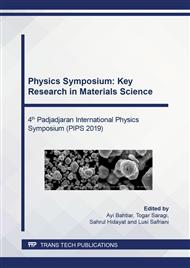p.3
p.9
p.15
p.22
p.28
p.34
p.42
p.53
Improved the Performance and Stability at High Humidity of Perovskite Solar Cells by Mixed Cesium-Metylammonium Cations
Abstract:
Perovskite solar cells have a great potential as competitor of silicon solar cells which have been dominated the market of solar cells since last decade, due to a tremendous improvement of their power conversion efficiency (PCE). Recently, a PCE of perovskite solar cells above 23% have been obtained. Moreover, perovskite solar cells can be fabricated using simple solution methods, therefore, the whole cost production of solar cells is less than half of silicon solar cells. However, their low stability in thermal and high humidity hinder them to be produced and commercially used to replace silicon solar cells. Many efforts have been done to improve both PCE and stability, including mixed inorganic-organic cations, mixed halide anions, improvement of perovskite morphology or crystallinity and using small molecules for passivation of defect in perovskite. In this paper, we used mixed cesium-methylammonium to improve both PCE and stability of perovskite solar cells. Cesium was used due to its smaller ionic radius than methylammonium (MA) ions, therefore, the crystal structure of perovskite is not distorted. Moreover, perovskite cesium-lead-bromide (CsPbBr3) are more stable than that of MAPbBr3 and doping cesium increased light absorption in perovskite MAPbBr3. We studied the effect of mixed cesium-MA on the PCE and stability at high humidity (>70%). The percentage of cesium was varied at 0%, 5%, 10%, 15% and 20%. The perovskite solar cells have monolithic hole-transport layer free (HTL-free) structure using carbon as electrode. This structure was used due simple and low cost in processing of solar cells. Our results showed that by replacing 10% of MA ions with Cs ions, both PCE and stability at high humidity are improved.
Info:
Periodical:
Pages:
9-14
Citation:
Online since:
August 2020
Authors:
Price:
Сopyright:
© 2020 Trans Tech Publications Ltd. All Rights Reserved
Share:
Citation:


